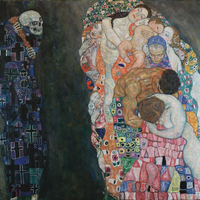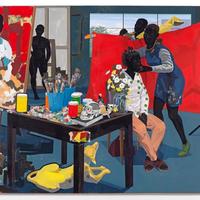More about Untitled (Studio)
- All
- Info
- Shop

Contributor
Kerry James Marshall shows that Black Lives Matter by painting them into some of the most recognizable pictures in history.
This particular painting is referencing Gustave Courbet’s The Painter’s Studio, but look closely and you’ll see that allusions to other famous artworks abound. Just squint a bit at all that clutter on the table and you’ll be able to pick out Carel Fabritius’s Goldfinch pecking away at some seeds, Betye Saar’s iconic image of Aunt Jemima cheekily tucked away behind a plateful of pancakes, and some good ol’ fashioned memento mori symbolism thrown into the mix for good measure. As in his 2009 Untitled (Painter) series, which draws upon the longstanding tradition of the self-portrait of the artist painting their own self-portrait to make a point about constraints placed upon the contemporary artist by past artistic conventions, Marshall here depicts the Black artist painting within the framework of a long-established artistic genre, but with a few key differences.
Marshall’s artist, significantly, isn’t male but female, and Courbet’s inexplicable female nude (the dude’s painting a landscape—why is she even there?) has been transformed here by Marshall into a naked man power posing in the background, presumably waiting to have his portrait painted next. In other words, Marshall has managed to comment both on the embarrassing dearth of Black representation and of works by female artists throughout art history, all in one go.
It’s fun to pick out all the references in Marshall’s paintings—I personally feel like I’m doing an I Spy puzzle whenever I look at them, and I love it—but his allusions aren’t just there to show off how well-versed he is in art history. Marshall himself has confirmed that he does try to fit as many formal styles and symbols from the past as he can into his work, and that his selections are far from random. The heap of references on the table, for example, can be interpreted as speaking broadly to the accumulated weight of past artistic conventions that a contemporary artist can’t help but feel while they’re working. This can be both a burden and a blessing, but Marshall himself has spoken on how he considers it a privilege to be working in the present moment for this very reason. To use his words:
“If I look back at da Vinci, Michelangelo, Rembrandt, you know, Raphael, Delacroix, all of those people. If I look back at those artists’ work, none of them had access to the kind of formal elements that come with people like Rauschenberg and Jasper Johns and Andy Warhol and Jackson Pollock and de Kooning and Rothko. They didn’t have access to that. So there was a way in which they didn’t have the ingredients to put things together in a way that artists who are operating in this historical moment can. So I’m not reacting against tradition—I’m simply trying to find a way to extend the dialogue and make paintings that appear to be fresh in some way.”
This does something to illuminate why the references are all sitting clustered together on the table, right next to the artist’s paint and brushes. These historical influences, like the paint itself, are being positioned by Marshall as the “ingredients” that go into the creation of contemporary art, there for artists to include, juxtapose, and layer on however they see fit. Each reference has its own particular meaning, too—the nod to Saar’s The Liberation of Aunt Jemima, for example, could be interpreted as an allusion to all the racist depictions of Black people that contemporary Black artists have to contend with when representing Black subjects today, while the insertion of Fabritius’s Goldfinch could represent the profound influence that works of the Western canon are still exerting on contemporary culture, centuries after they were painted. Untitled (Studio) was painted the year after Donna Tartt’s bestselling novel The Goldfinch was published, a book whose plot centers entirely around the tiny, yet immensely valuable painting (it was estimated to be worth about $300 million in 2014). Finally, it’s significant that the memento mori skull on the table is not quite dead; its eyeballs bulge and stare, suggesting an artistic past that lives on in the present, or perhaps evoking the feeling of being unable to escape a way of seeing the world that has been shaped by the art of times past.
Like the Courbet painting it’s imitating, Untitled (Studio) is monumental in size. Marshall is making a statement by giving his painting such substantial dimensions, just as Courbet was back in 1855. At the time, such a scale was generally reserved for the ranks of history painting, then considered the most “serious” of all artistic genres. By painting his own artistic practice on such a grand scale, Courbet implied that his work carried the same significance as scenes from mythology and history. Marshall, similarly, tacitly argues for the significance of his subjects by giving them such an expansive space. According to one interview, it’s always been part of his artistic mission to create “work that entered into the museum on a scale that was equal to anything else you might see in there,” meaning not only that he wants it to be as good as any painting by an old master, but also that he wants it to be able to compete with those paintings for the attention of museum goers. By making his paintings large in scale and bright in color, he ensures that they’ll immediately draw the eye.
Marshall is on a mission to paint the lives of Black people into an artistic lineage that, until now, has rendered them invisible—hence his choice to sometimes use existing works, like Courbet’s The Painter’s Studio and Judith Leyster’s Self Portrait, as templates for his paintings. By doing so, he’s literally painting Black subjects into the Western canon—but that’s far from being the only thing that carries significance in his paintings. Marshall is also very interested in refiguring the way in which Black subjects are represented in art, aiming to construct them as an ideal—as his ideal—in the same way that white people have constructed themselves as ideals for hundreds of years. “You can’t underestimate the value of a figure in a picture that is self-satisfied,” he’s said in an interview, “Especially given that the history of Black people in the United States and other parts of the world is that it’s somehow compromised and always traumatic.”
Sources
- Charles, Ron. “‘The Goldfinch’ — in print and paint.” The Washington Post. July 14, 2014. https://www.washingtonpost.com/news/arts-and-entertainment/wp/2014/07/1…- goldfinch-in-print-and-paint.
- Hardy-Phillips, Yvonne. “Mastry Calls Out the Western Canon.” Full Bleed: A Journal of Art and Design. April 1, 2017. https://www.full-bleed.org/features/2017/5/8/kerry-james- marshall-retrospective.
- Laster, Paul. “Kerry James Marshall: ‘I love art thanks to Leonardo da Vinci’ (an interview).” Conceptual Fine Arts. November 15, 2019. https://www.conceptualfinearts.com/ cfa/2016/12/02/kerry-james-marshall-at-the-met-my-love-of-art-making-came-
- MOCA. “Process: Kerry James Marshall.” March 31, 2017. YouTube video, 2:56. https://www.youtube.com/watch?v=WNiGOR4LenU.
- Museum of Contemporary Art Chicago. “Kerry James Marshall: Mastry.” May 2, 2016. YouTube video, 7:34. https://www.youtube.com/watch?v=K2bmHE7MRQU.
- Rowell, Charles H. and Kerry James Marshall. “An Interview with Kerry James Marshall.” Callaloo 21, no. 1 (1998): 263-272.
- Smarthistory. “Courbet, The Painter’s Studio.” January 9, 2018. YouTube video, 8:17. https://www.youtube.com/watch?v=iFHIL6rZnj0&t=234s.
- “Untitled (Studio).” The Met. Accessed June 22, 2020. https://www.metmuseum.org/art/ collection/search/669451.














